Small scale recycling efforts are under way but most rubbish still ends up in landfills and waste-to-energy plans have stalled.
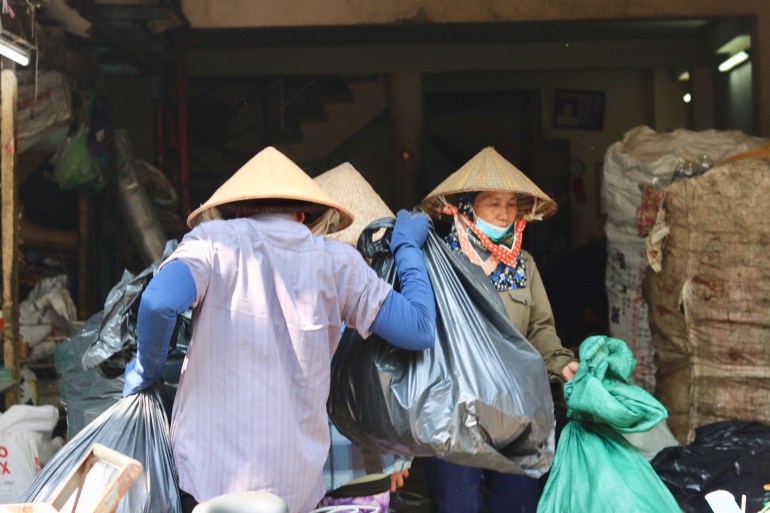
Waste pickers, or ve chai, are the driving force behind recycling in Ho Chi Minh City
[Govi Snell/Al Jazeera]
Published On 30 Nov 2022
Ho Chi Minh City – Kieu Anh Tran heads down a small alley to her workshop in Ho Chi Minh City’s Binh Thanh District. Inside, her team is busy washing used plastic tarpaulins, cutting patterns, and sewing the discarded material into backpacks, tote bags, and wallets.
In Vietnam’s southern city and commercial hub, there is no official recycling system. Its population of more than 10 million produces about 9,500 tonnes of domestic rubbish every day, and if Tran did not repurpose the tarps once used for shop awnings and as truck covers, they too would be headed to the dump.
“We recycle plastic every day, we know how bad it is. But when you hear about it in the large scale and you hear about how many tonnes of trash is coming out of Saigon … it is so stressful,” Tran told Al Jazeera, using the city’s former name.
“When you work on this kind of thing you have to stay positive. It can drag you down to think you can’t help much,” she said of her business making bags out of used tarps.
Ho Chi Minh City authorities are tasked with controlling waste management and contract private and government-owned companies to collect rubbish and operate landfills where waste is dumped and buried. But the expanding city is producing ever more waste, and Ho Chi Minh City’s two main landfills are filling up.
The United Nations’s first intergovernmental negotiations to agree on a legally binding instrument on plastic pollution are currently under way. With Vietnam among the top 5 nations contributing to ocean plastic, the spotlight will be on the country to rein in its mismanaged waste.
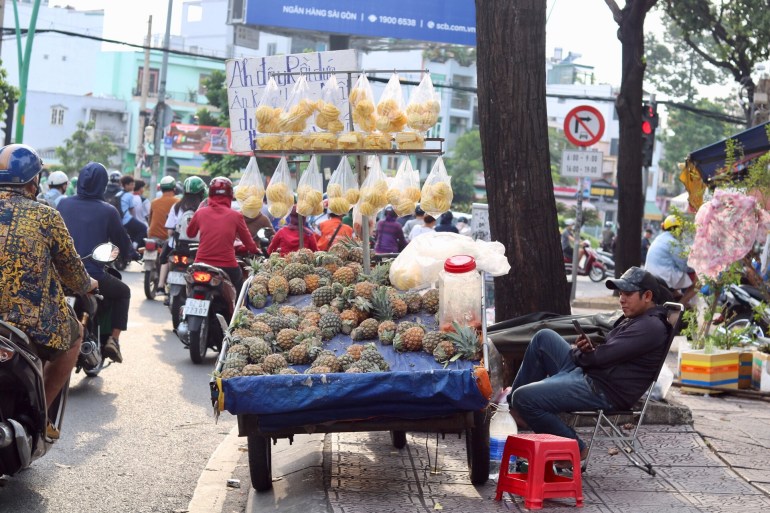
Single-use plastics are a common sight throughout Ho Chi Minh City [Govi Snell/A; Jazeera]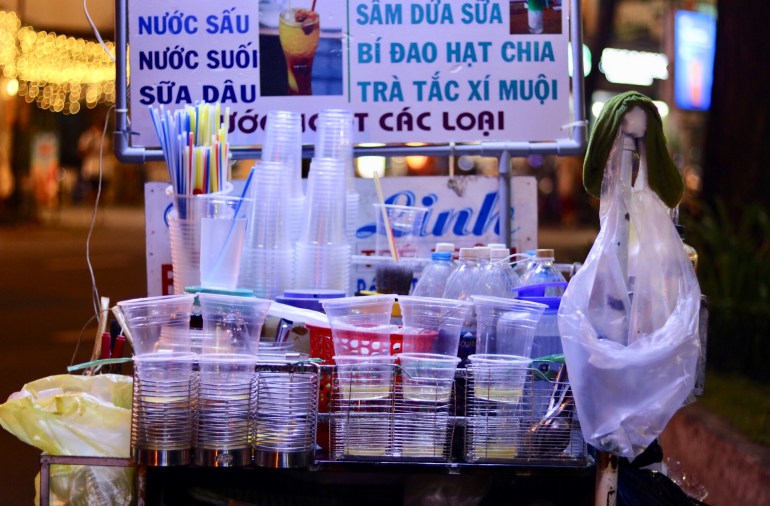

Plastics usually end up in the southern Vietnamese city’s rapidly-expanding landfills, with only a tiny proportion of items recycled [Govi Snell/Al Jazeera]
For those living near the city’s dumps, action cannot come quickly enough.
Tuan Nguyen lives about 10km (6 miles) from Ho Chi Minh City’s largest dump, Da Phuoc. When the wind shifts in his direction, the stench from the decaying rubbish fills his home.
“The smell is very bad even from 10 kilometres away … It is a very unacceptable situation,” he said. “Not any single [piece of] waste is handled properly [and] the volume of Da Phuoc is increasing day by day.”
For those living near the city’s dumps, action cannot come quickly enough.
Tuan Nguyen lives about 10km (6 miles) from Ho Chi Minh City’s largest dump, Da Phuoc. When the wind shifts in his direction, the stench from the decaying rubbish fills his home.
“The smell is very bad even from 10 kilometres away … It is a very unacceptable situation,” he said. “Not any single [piece of] waste is handled properly [and] the volume of Da Phuoc is increasing day by day.”
Burning plastic
Across Vietnam, just 27 percent of the plastic waste generated each year is recycled.
After a revision to Vietnam’s Law on Environmental Protection went into effect this January, the country’s municipalities were made responsible for sorting and recycling waste. But without enforcement or implementation, there continues to be no official recycling mechanism.
Ho Chi Minh City authorities have proposed incineration and the conversion of waste to energy as the best solution to its waste problem. Under a management plan that runs until 2025, landfills will gradually be closed and 80 percent of the city’s waste will be converted into energy through incineration
Across Vietnam, just 27 percent of the plastic waste generated each year is recycled.
After a revision to Vietnam’s Law on Environmental Protection went into effect this January, the country’s municipalities were made responsible for sorting and recycling waste. But without enforcement or implementation, there continues to be no official recycling mechanism.
Ho Chi Minh City authorities have proposed incineration and the conversion of waste to energy as the best solution to its waste problem. Under a management plan that runs until 2025, landfills will gradually be closed and 80 percent of the city’s waste will be converted into energy through incineration
.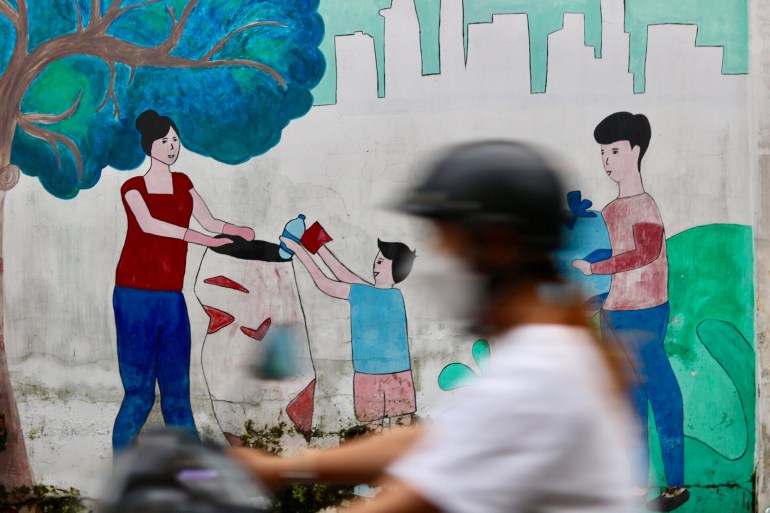

While Ho Chi Minh City murals promote recycling, there is no official recycling system in the city [Govi Snell/Al Jazeera]
A groundbreaking ceremony was held in Cu Chi District for the construction of a $400m waste-to-energy plant in August 2019, one of three planned projects. Sparklers went off as men dressed in business clothes and wearing hard hats shovelled sand.
The Vietstar Joint Stock Company plant was slated to open in 2020 with the capacity to process 4,000 tonnes of rubbish daily by 2021. Two other companies, Tam Sinh Nghia and Tasco, also began building waste-to-energy plants in 2019, with each of their facilities designed to process 6,000 tonnes of waste a day.
But none of the projects have been completed.
Part of the problem is the country’s national power development plan, the still to be finalised PDP8, which will specify the country’s energy mix from 2021 until 2030, and lay out a vision towards 2045.
Vietnam pledged at last year’s climate talks to reach net-zero carbon emissions by 2050, but at this year’s just concluded summit in Sharm el-Sheikh, it failed to reach a funding deal with G7 countries to support its clean energy transition.
A revised draft of PDP8 released by the Ministry of Industry and Trade on November 11 outlined an increase in the use of coal power until 2030 and a decrease in renewable energy targets.
It was the absence of PDP8 that Vietstar said had prevented it from starting operations. Tam Sinh Nghia and Tasco are also being held up by bottlenecks in the approval process, according to local media.
Although Ho Chi Minh City’s waste-to-energy plans are at a standstill, other parts of Vietnam are embracing incineration as an energy source.
In July, the country’s largest incineration plant began operating in the capital, Hanoi. The plant can burn 4,000 tonnes of dry waste daily and produce as much as 15 megawatts of power for the national grid.
But while some see the potential for controlled waste incineration, others worry about the effect on people’s health.
“There are a lot of negative impacts of incinerators. As a zero-waste solution, incineration is a false solution, including waste-to-energy,” Xuan Quach, coordinator at Vietnam Zero Waste Alliance, told Al Jazeera.
Along with releasing greenhouse gases and chemicals, including dioxin and furan, Quach says incineration does nothing to encourage recycling or discourage plastic use.
In 2019, Vietnam’s plastic industry contributed $17.5bn to the national economy, equivalent to nearly 7 percent of the gross domestic product (GDP).
Like Quach, Yobel Novian Putra at the Global Initiative for Incinerator Alternatives worries about the potential harms of burning waste.
“Dioxin is one of the most toxic group of chemicals,” he said, citing that the chemical has been shown to cause cancer and long-term hormonal issues which can be passed down generations.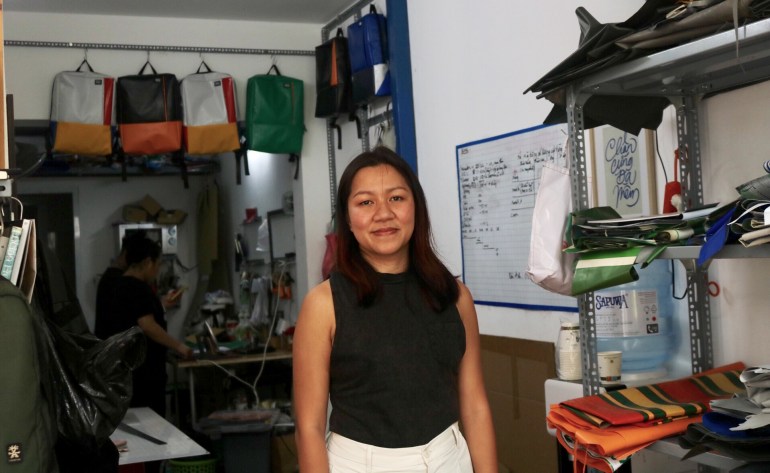
A groundbreaking ceremony was held in Cu Chi District for the construction of a $400m waste-to-energy plant in August 2019, one of three planned projects. Sparklers went off as men dressed in business clothes and wearing hard hats shovelled sand.
The Vietstar Joint Stock Company plant was slated to open in 2020 with the capacity to process 4,000 tonnes of rubbish daily by 2021. Two other companies, Tam Sinh Nghia and Tasco, also began building waste-to-energy plants in 2019, with each of their facilities designed to process 6,000 tonnes of waste a day.
But none of the projects have been completed.
Part of the problem is the country’s national power development plan, the still to be finalised PDP8, which will specify the country’s energy mix from 2021 until 2030, and lay out a vision towards 2045.
Vietnam pledged at last year’s climate talks to reach net-zero carbon emissions by 2050, but at this year’s just concluded summit in Sharm el-Sheikh, it failed to reach a funding deal with G7 countries to support its clean energy transition.
A revised draft of PDP8 released by the Ministry of Industry and Trade on November 11 outlined an increase in the use of coal power until 2030 and a decrease in renewable energy targets.
It was the absence of PDP8 that Vietstar said had prevented it from starting operations. Tam Sinh Nghia and Tasco are also being held up by bottlenecks in the approval process, according to local media.
Although Ho Chi Minh City’s waste-to-energy plans are at a standstill, other parts of Vietnam are embracing incineration as an energy source.
In July, the country’s largest incineration plant began operating in the capital, Hanoi. The plant can burn 4,000 tonnes of dry waste daily and produce as much as 15 megawatts of power for the national grid.
But while some see the potential for controlled waste incineration, others worry about the effect on people’s health.
“There are a lot of negative impacts of incinerators. As a zero-waste solution, incineration is a false solution, including waste-to-energy,” Xuan Quach, coordinator at Vietnam Zero Waste Alliance, told Al Jazeera.
Along with releasing greenhouse gases and chemicals, including dioxin and furan, Quach says incineration does nothing to encourage recycling or discourage plastic use.
In 2019, Vietnam’s plastic industry contributed $17.5bn to the national economy, equivalent to nearly 7 percent of the gross domestic product (GDP).
Like Quach, Yobel Novian Putra at the Global Initiative for Incinerator Alternatives worries about the potential harms of burning waste.
“Dioxin is one of the most toxic group of chemicals,” he said, citing that the chemical has been shown to cause cancer and long-term hormonal issues which can be passed down generations.

Kieu Anh Tran’s recycling business turns old shop awnings and other used plastics into backpacks, tote bags, and wallets [Govi Snell/Al Jazeera]
A US study published in 2020 found women who lived 10km (6.2 miles) from any solid municipal waste incinerators had increased breast cancer risks. Burning rubbish and poor waste management have also been linked to the development of “cancer villages” across Vietnam.
And while Ho Chi Minh City’s waste-to-energy plants promise advanced technologies to minimise toxic emissions in the burning process, Putra worries about a lack of oversight.
“There is no credibility,” Putra told Al Jazeera. “Transparency is an issue when you’re dealing with private companies.”
For Hong Quan Nguyen, director of the Institute for Circular Economy Development at Ho Chi Minh City National University, incineration is not an ideal solution but could help reduce waste overflow at landfills and contribute to the circular economy with energy output.
“When we’re talking about circular economy solutions [waste-to-energy] is just better than the landfill … you can collect some energy for Ho Chi Minh City,” he said. “We have to make sure the solution has no environmental impacts … we have to do it carefully.”
Mismanaged waste
Although there is no official recycling mechanism in Ho Chi Minh City, waste pickers, or ve chai, are the driving force of recycling. They make a meagre income by collecting plastic bottles, cardboard, and metal and then selling the goods to informal recycling centres.
What the ve chai do not gather is collected at households and businesses and trucked to landfills. Solid municipal waste often goes unsorted or treated, and plastic is piled or buried along with food waste and other types of rubbish
A US study published in 2020 found women who lived 10km (6.2 miles) from any solid municipal waste incinerators had increased breast cancer risks. Burning rubbish and poor waste management have also been linked to the development of “cancer villages” across Vietnam.
And while Ho Chi Minh City’s waste-to-energy plants promise advanced technologies to minimise toxic emissions in the burning process, Putra worries about a lack of oversight.
“There is no credibility,” Putra told Al Jazeera. “Transparency is an issue when you’re dealing with private companies.”
For Hong Quan Nguyen, director of the Institute for Circular Economy Development at Ho Chi Minh City National University, incineration is not an ideal solution but could help reduce waste overflow at landfills and contribute to the circular economy with energy output.
“When we’re talking about circular economy solutions [waste-to-energy] is just better than the landfill … you can collect some energy for Ho Chi Minh City,” he said. “We have to make sure the solution has no environmental impacts … we have to do it carefully.”
Mismanaged waste
Although there is no official recycling mechanism in Ho Chi Minh City, waste pickers, or ve chai, are the driving force of recycling. They make a meagre income by collecting plastic bottles, cardboard, and metal and then selling the goods to informal recycling centres.
What the ve chai do not gather is collected at households and businesses and trucked to landfills. Solid municipal waste often goes unsorted or treated, and plastic is piled or buried along with food waste and other types of rubbish
.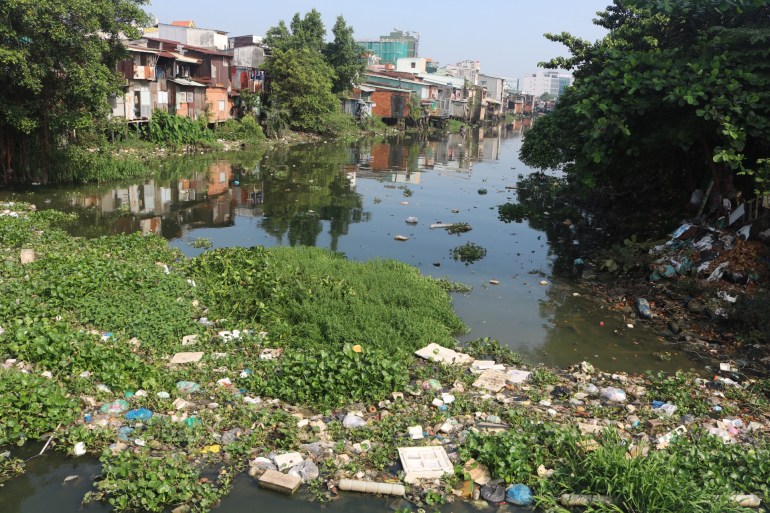

Plastic waste often gets tangled among the water hyacinth in Ho Chi Minh City’s waterways
[Govi Snell/Al Jazeera]
Da Phuoc was opened in 2007 in Binh Chanh District, approximately a 45-minute drive from the centre of Ho Chi Minh City. The landfill covers 138 hectares (341 acres), but with about two-thirds of the city’s waste trucked to Da Phuoc, space is running out.
Nguyen and other residents affected by Da Phuoc congregate in Facebook groups to discuss the issues they face due to the waste site. Although previous protests and messages sent by group members to city officials to close the dump have gone unheeded, they are not giving up.
“In the next few months we will go together to submit a letter to the officials,” Nguyen said. “I plan to ask city authorities to stop burying garbage and use new technology to handle it properly.”
In 2017, residents claimed the landfill was polluting waterways after people living nearby noticed a foamy and foul-smelling layer on the surface of a nearby river.
Worried about the problems the pollution could cause for their health and for fishing businesses, residents blocked the entrance to the landfill overnight, stopping rubbish trucks from bringing more waste into the site.
Vietnam Waste Solutions (VWS), the owner and operator of Da Phuoc, criticised residents for “spreading rumours” and scaring their workers. The company claimed the foamy and bad-smelling water was the result of sand used for construction at the landfill mixing with the water after a heavy rain. The year before however, the company had been fined $66,100 for illegally discharging waste.
VWS President and CEO David Trung Duong also runs a waste management company in the United States – California Waste Solutions. From Nguyen’s perspective, corruption has played a role in the landfill being able to continue operations despite poor management. He said that despite claims from the company’s CEO that waste would be treated and sorted with advanced technology, the lack of proper management has led to the pollution that plagues residents.
“The volume of Da Phuoc is increasing so they cannot tolerate it any longer,” Nguyen said of those calling for the landfill’s closure. “I am very, very sad and disappointed about the government.”
In the absence of a city-wide approach to managing waste, residents are taking matters into their own hands
Da Phuoc was opened in 2007 in Binh Chanh District, approximately a 45-minute drive from the centre of Ho Chi Minh City. The landfill covers 138 hectares (341 acres), but with about two-thirds of the city’s waste trucked to Da Phuoc, space is running out.
Nguyen and other residents affected by Da Phuoc congregate in Facebook groups to discuss the issues they face due to the waste site. Although previous protests and messages sent by group members to city officials to close the dump have gone unheeded, they are not giving up.
“In the next few months we will go together to submit a letter to the officials,” Nguyen said. “I plan to ask city authorities to stop burying garbage and use new technology to handle it properly.”
In 2017, residents claimed the landfill was polluting waterways after people living nearby noticed a foamy and foul-smelling layer on the surface of a nearby river.
Worried about the problems the pollution could cause for their health and for fishing businesses, residents blocked the entrance to the landfill overnight, stopping rubbish trucks from bringing more waste into the site.
Vietnam Waste Solutions (VWS), the owner and operator of Da Phuoc, criticised residents for “spreading rumours” and scaring their workers. The company claimed the foamy and bad-smelling water was the result of sand used for construction at the landfill mixing with the water after a heavy rain. The year before however, the company had been fined $66,100 for illegally discharging waste.
VWS President and CEO David Trung Duong also runs a waste management company in the United States – California Waste Solutions. From Nguyen’s perspective, corruption has played a role in the landfill being able to continue operations despite poor management. He said that despite claims from the company’s CEO that waste would be treated and sorted with advanced technology, the lack of proper management has led to the pollution that plagues residents.
“The volume of Da Phuoc is increasing so they cannot tolerate it any longer,” Nguyen said of those calling for the landfill’s closure. “I am very, very sad and disappointed about the government.”
In the absence of a city-wide approach to managing waste, residents are taking matters into their own hands
.

Workers clean discarded plastic at the Dong Dong Saigon workshop for repurposing into new products [Govi Snell/Al Jazeera]
Along with Tran’s business making bags from used tarpaulin sheets, some stall holders at local markets have set up refill stations to reduce plastic waste while others have begun to use paper packaging for foods, shouldering any additional cost.
In a small office in District 3, Nguyen Ngoc Anh leads a team of volunteers planning the next campaign for the non-profit Xanh Vietnam. The team organises rubbish collection drives in many locations across the country. In October, the non-profit led 150 volunteers to collect rubbish in Ho Chi Minh City’s Thu Thiem Ward and collected 100 bags of rubbish within two hours with the support of local authorities.
Anh founded her non-profit after a trip to Vung Tau, a coastal city just more than two hours drive from Ho Chi Minh City. There, she saw children sitting on the beach making sandcastles out of a mixture of sand and plastic waste.
“Years ago, we lived in an environment where we could live freely and play without any plastic,” she told Al Jazeera. “But the younger generation nowadays, they have to bear the burden of our habit of destroying the environment.”
Along with Tran’s business making bags from used tarpaulin sheets, some stall holders at local markets have set up refill stations to reduce plastic waste while others have begun to use paper packaging for foods, shouldering any additional cost.
In a small office in District 3, Nguyen Ngoc Anh leads a team of volunteers planning the next campaign for the non-profit Xanh Vietnam. The team organises rubbish collection drives in many locations across the country. In October, the non-profit led 150 volunteers to collect rubbish in Ho Chi Minh City’s Thu Thiem Ward and collected 100 bags of rubbish within two hours with the support of local authorities.
Anh founded her non-profit after a trip to Vung Tau, a coastal city just more than two hours drive from Ho Chi Minh City. There, she saw children sitting on the beach making sandcastles out of a mixture of sand and plastic waste.
“Years ago, we lived in an environment where we could live freely and play without any plastic,” she told Al Jazeera. “But the younger generation nowadays, they have to bear the burden of our habit of destroying the environment.”
SOURCE: AL JAZEERA
No comments:
Post a Comment